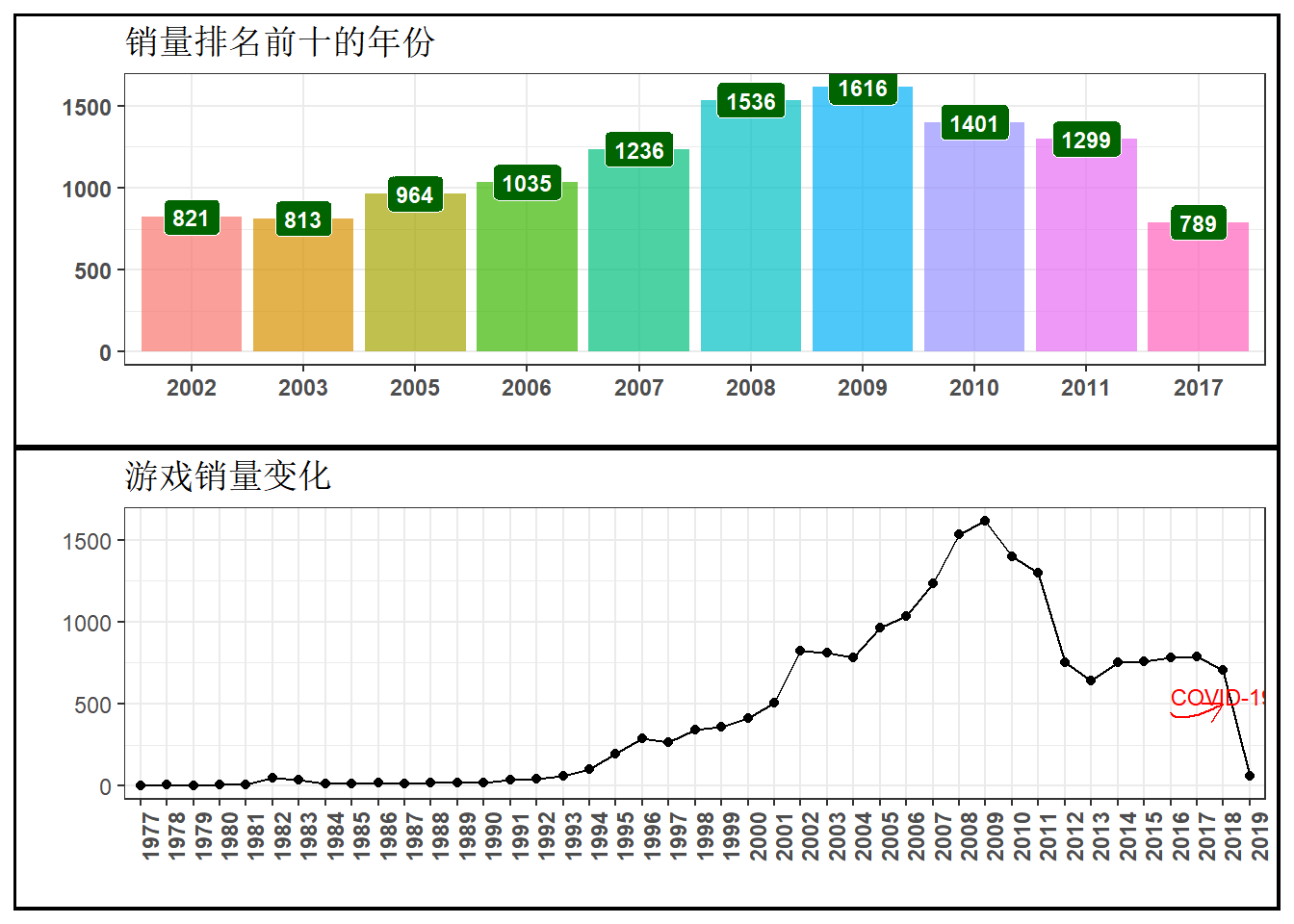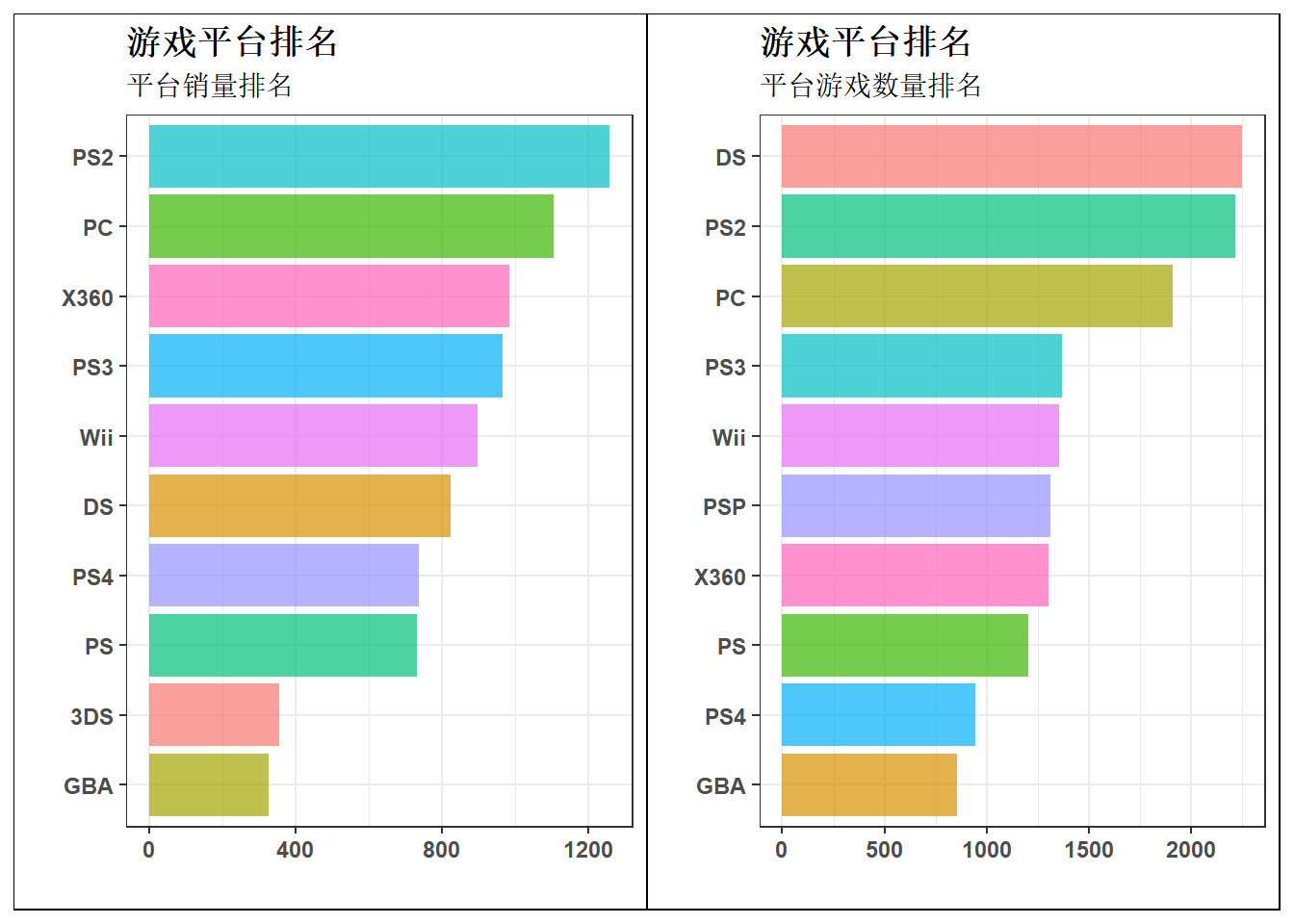file <- "d:/myblog/datas/vgsales.csv"
df <- read_csv(file)
str(df)
## spc_tbl_ [19,600 × 9] (S3: spec_tbl_df/tbl_df/tbl/data.frame)
## $ Rank : num [1:19600] 1 2 3 4 5 6 7 8 9 10 ...
## $ Name : chr [1:19600] "Wii Sports" "Super Mario Bros." "Counter-Strike: Global Offensive" "Mario Kart Wii" ...
## $ Platform : chr [1:19600] "Wii" "NES" "PC" "Wii" ...
## $ Publisher : chr [1:19600] "Nintendo" "Nintendo" "Valve" "Nintendo" ...
## $ Developer : chr [1:19600] "Nintendo EAD" "Nintendo EAD" "Valve Corporation" "Nintendo EAD" ...
## $ Critic_Score : num [1:19600] 7.7 10 8 8.2 8.6 10 8 9.4 9.1 8.6 ...
## $ User_Score : num [1:19600] 8 8.2 7.5 9.1 4.7 7.8 8.8 8.8 8.1 9.2 ...
## $ Total_Shipped: num [1:19600] 82.9 40.2 40 37.3 36.6 ...
## $ Year : num [1:19600] 2006 1985 2012 2008 2017 ...
## - attr(*, "spec")=
## .. cols(
## .. Rank = col_double(),
## .. Name = col_character(),
## .. Platform = col_character(),
## .. Publisher = col_character(),
## .. Developer = col_character(),
## .. Critic_Score = col_double(),
## .. User_Score = col_double(),
## .. Total_Shipped = col_double(),
## .. Year = col_double()
## .. )
## - attr(*, "problems")=<externalptr>
head(df, 3)
## # A tibble: 3 × 9
## Rank Name Platform Publisher Developer Critic_Score User_Score Total_Shipped
## <dbl> <chr> <chr> <chr> <chr> <dbl> <dbl> <dbl>
## 1 1 Wii … Wii Nintendo Nintendo… 7.7 8 82.9
## 2 2 Supe… NES Nintendo Nintendo… 10 8.2 40.2
## 3 3 Coun… PC Valve Valve Co… 8 7.5 40
## # ℹ 1 more variable: Year <dbl>1 Video Games Sales
1.1 准备
数据共包括11列,包含了从1977年~2020年中的游戏销量数据。
1.2 缺失值处理
summary(df)
## Rank Name Platform Publisher
## Min. : 1 Length:19600 Length:19600 Length:19600
## 1st Qu.: 4899 Class :character Class :character Class :character
## Median : 9798 Mode :character Mode :character Mode :character
## Mean : 9799
## 3rd Qu.:14698
## Max. :19598
##
## Developer Critic_Score User_Score Total_Shipped
## Length:19600 Min. : 0.800 Min. : 1.000 Min. : 0.0100
## Class :character 1st Qu.: 6.100 1st Qu.: 6.300 1st Qu.: 0.0500
## Mode :character Median : 7.300 Median : 7.200 Median : 0.1600
## Mean : 7.035 Mean : 6.995 Mean : 0.5511
## 3rd Qu.: 8.200 3rd Qu.: 8.000 3rd Qu.: 0.4600
## Max. :10.000 Max. :10.000 Max. :82.9000
## NA's :9631 NA's :17377
## Year
## Min. :1977
## 1st Qu.:2004
## Median :2008
## Mean :2008
## 3rd Qu.:2012
## Max. :2020
##
sum(is.na(df))
## [1] 27010
n_miss(df)
## [1] 27010数据中有27010个缺失值,而缺失值主要存在与Critic_Score和User_Score,主要原因在于并不是每个用户和从业者都会对游戏进行评分。 需要对其进行一些处理,未打分的我们认为其打分为5.0分,即使用5.0代替所有缺失值。
# 采用每一列的众数替换该列的缺失值
df <- df %>%
map_dfc(~ replace_na(.x, rstatix::get_mode(.x)[1]))1.3 描述性分析
描述性统计是一个统计范围,它应用各种技术来描述和总结任何数据集,并研究观察到的数据的一般行为,以促进问题的解决。这可以通过频率表、图形和集中趋势的度量来完成,例如平均值、中位数、众数、离散度量(例如标准偏差、百分位数和四分位数)。
由于2020年只有前半段的数据,我们分析时将2020年的数据剔除,以便更好的分析对比各年份的差异。同时剔除
Rank列。
1.3.1 常规分析
1.3.1.1 哪一年的游戏总销量最高
df_shipped <- df %>%
select(Year, Total_Shipped) %>%
group_by(Year) %>%
summarise(count = n()) %>%
arrange(desc(count))p1 <- ggplot(head(df_shipped, 10), aes(
x = Year, y = count,
fill = Year
)) +
geom_bar(stat = "identity", alpha = 0.7) +
geom_label(aes(label = count),
fontface = "bold",
fill = "#006400",
color = "white",
size = 3
) +
theme_bw() +
labs(x = " ", y = " ") +
ggtitle("销量排名前十的年份") +
theme(
legend.position = "none",
plot.background = element_rect(color = "black", size = 1.1),
axis.text.x = element_text(face = "bold"),
axis.text.y = element_text(face = "bold"),
axis.title = element_text(face = "bold")
)
p2 <- ggplot(df_shipped, aes(x = Year, y = count, group = 1)) +
geom_point() +
geom_line() +
theme_bw() +
ggtitle("游戏销量变化") +
labs(x = " ", y = " ") +
theme(
plot.background = element_rect(color = "black", size = 1.1),
axis.text.x = element_text(face = "bold", angle = 90)
) +
geom_curve(
x = 40, y = 450, xend = 42, yend = 500,
angle = 35,
arrow = arrow(length = unit(0.3, "cm")),
color = "red"
) +
annotate("text",
x = 42, y = 550,
label = "COVID-19", color = "red", size = 3
)
p1 / p2由 图 1 可以看出:
销量排名前十的年份均在21世纪,且2009年销量最高。2009年之后,游戏销量逐渐下滑,在2011年左右趋于平稳。
2018~2019年,游戏销量急剧下滑。猜测原因为新冠肺炎疫情的爆发导致的游戏产能下降、经济下滑,从而大幅影响了游戏的销量。
下面我们将具体看一下各游戏平台的表现。
1.3.1.2 游戏平台排名(销量、游戏数量)
df_platform <- df %>%
select(Platform, Total_Shipped) %>%
group_by(Platform) %>%
summarize(amount = sum(Total_Shipped)) %>%
arrange(desc(amount)) %>%
head(10)
p3 <- ggplot(df_platform, aes(
x = reorder(Platform, amount), y = amount,
fill = Platform
)) +
geom_bar(stat = "identity", alpha = 0.7) +
labs(x = " ", y = " ") +
ggtitle("游戏平台排名", subtitle = "平台销量排名") +
coord_flip() +
theme_bw() +
theme(
legend.position = "none",
axis.text = element_text(face = "bold"),
plot.title = element_text(face = "bold"),
plot.background = element_rect(color = "black")
)
df_platform2 <- as.data.frame(table(df$Platform)) %>%
rename(Platform = Var1) %>%
arrange(desc(Freq)) %>%
head(10)
p4 <- ggplot(df_platform2, aes(
x = reorder(Platform, Freq), y = Freq,
fill = Platform
)) +
geom_bar(stat = "identity", alpha = 0.7) +
labs(x = " ", y = " ") +
ggtitle("游戏平台排名", subtitle = "平台游戏数量排名") +
coord_flip() +
theme_bw() +
theme(
plot.background = element_rect(color = "black"),
legend.position = "none",
plot.title = element_text(face = "bold"),
axis.text = element_text(face = "bold")
)
p3 | p4由 图 2 可以看出:
- PS2不愧是有史以来最成功的的家用主机,发行在其上的游戏销量排名第一、游戏数量排名第二。
- PC游戏仍有一定竞争力。
- 御三家统治了主机游戏。
下面我们看一下游戏开发商的情况。
1.3.1.3 开发商和发行商排名
df_developer <- df %>%
select(Developer, Total_Shipped) %>%
group_by(Developer) %>%
summarise(amount = sum(Total_Shipped)) %>%
arrange(desc(amount)) %>%
head(10)
p5 <- ggplot(df_developer, aes(
x = reorder(Developer, amount), y = amount,
fill = Developer
)) +
geom_bar(stat = "identity", alpha = 0.7) +
coord_flip() +
ggtitle("开发商销量排名") +
labs(x = " ", y = "") +
theme_bw() +
theme(
legend.position = "none",
plot.background = element_rect(color = "black")
)df_publisher <- df %>%
select(Publisher, Total_Shipped) %>%
group_by(Publisher) %>%
summarise(amount = sum(Total_Shipped)) %>%
arrange(desc(amount)) %>%
head(10)
p6 <- ggplot(df_publisher, aes(
x = reorder(Publisher, amount), y = amount,
fill = Publisher
)) +
geom_bar(stat = "identity", alpha = 0.7) +
coord_flip() +
ggtitle("发行商销量排名") +
labs(x = " ", y = "") +
theme_bw() +
theme(
legend.position = "none",
plot.background = element_rect(color = "black")
)
p5 | p6
- 任天堂作为开发商和发行商均独占鳌头。
- Game Freak依靠王牌IP精灵宝可梦占据开发商销量第三名。
- 大家耳熟能详的游戏开发商和发行商均有上榜。
1.4 探索性分析
在统计学中,探索性数据分析 (EAD) 是一种分析数据集以总结其主要特征的方法,通常使用可视化方法。
1.4.1 世界最畅销游戏
1.4.1.1 最畅销的5个游戏
那么,1977年~2019年间,到底哪个游戏销量是最高的呢?
options(repr.plot.width = 20, repr.plot.height = 8)
df_games <- df %>%
select(Name, Total_Shipped) %>%
group_by(Name) %>%
summarise(amount = sum(Total_Shipped)) %>%
arrange(desc(amount)) %>%
head(5)
p7 <- ggplot(df_games, aes(
x = reorder(Name, amount), y = amount,
fill = Name
)) +
geom_col(aes(alpha = 0.9)) +
geom_label(aes(label = amount),
size = 3,
fontface = "bold",
color = "white"
) +
labs(x = " ", y = " ") +
coord_flip() +
theme_bw() +
theme(
legend.position = "none",
plot.background = element_rect(color = "black", size = 1.1),
axis.text.x = element_text(face = "bold"),
axis.text.y = element_text(face = "bold")
)
p8 <- ggplot(df_games, aes(x = Name, y = amount)) +
geom_line(alpha = 0.7, group = 1) +
geom_point(aes(fill = Name), shape = 2) +
theme_bw() +
theme(
legend.position = "none",
plot.background = element_rect(color = "black"),
axis.text.x = element_text(face = "bold")
) +
labs(x = "", y = "") +
coord_polar()
p7 | p8由 图 3 可知:
- 游戏销量排名前3的游戏为:Wii Sports、GTA5和我的世界。
- GTV5和我的世界在多个游戏平台均有发售,Wii Sports为任天堂平台独占。
- 任天堂游戏平台发售的游戏占前十的大多数,任天堂就是世界的主宰!
1.4.1.2 最畅销的5个游戏逐年分布
df_games_top5 <- df %>%
filter(Name == "Wii Sports" |
Name == "Grand Theft Auto V" |
Name == "Minecraft" |
Name == "Super Mario Bros." |
Name == "Counter-Strike: Global Offensive") %>%
select(Name, Year, Total_Shipped)
ggplot(df_games_top5, aes(x = Year, y = Total_Shipped)) +
geom_bar(
stat = "identity", aes(
fill = Name,
color = Name
),
alpha = 8
) +
facet_wrap(~Name) +
labs(x = "", y = "总销量(百万套)") +
theme_bw() +
theme(
legend.position = "none",
strip.text.x = element_text(
margin = margin(7, 7, 7, 7), size = 7,
face = "bold", color = "white"
),
strip.background = element_rect(
fill = "#B45F04",
color = "black"
),
plot.title = element_text(face = "bold"),
axis.text.x = element_text(
face = "bold",
angle = 90,
vjust = 0.5
),
axis.text.y = element_text(face = "bold")
)
1.5 媒体打分与玩家打分的关系
俗话说,“低分信媒体,高分信自己”。如果一款游戏媒体打分低,那肯定不行,但如果一个游戏媒体打高分,也不一定好玩(有可能是塞了钱)。
下面我们就分析一下媒体打分与玩家打分的关系。
df_score <- df %>%
select(Name, User_Score, Critic_Score)
cor <- cor.test(df_score$User_Score, df_score$Critic_Score,
method = "pearson"
)
p.value <- cor$p.value
coef <- cor$estimate
ggplot(df_score, aes(x = User_Score, y = Critic_Score)) +
geom_smooth(method = lm)
可以看到两个打分的相关系数为0.16,且p值小于0.05,表明两者呈现显著的正相关。看来游戏媒体和玩家对游戏的口味还是一样的,某种程度上说,高分也可以信媒体。
1.6 玩家与媒体分别最喜欢哪个发行商
1.6.1 玩家
那么,玩家最喜欢(打分最高)的游戏发行商是谁呢?
df_player <- df %>%
select(Publisher, User_Score)
df_player$Publisher <- df_player$Publisher %>%
map(~
str_detect(.x, "Sony") %>%
ifelse("Sony", .x)) %>%
unlist()
df_player <- df_player %>%
group_by(Publisher) %>%
summarise(
count = n(),
mean_score = mean(User_Score)
) %>%
filter(count >= 50) %>%
select(Publisher, mean_score) %>%
arrange(desc(mean_score))
df_player
## # A tibble: 62 × 2
## Publisher mean_score
## <chr> <dbl>
## 1 Rockstar Games 7.84
## 2 Microsoft Game Studios 7.77
## 3 Nintendo 7.77
## 4 Sierra Entertainment 7.72
## 5 DreamCatcher Interactive 7.71
## 6 5pb 7.71
## 7 Sony 7.70
## 8 Eidos Interactive 7.70
## 9 Acclaim Entertainment 7.7
## 10 Agetec 7.7
## # ℹ 52 more rows在发行过50个以上游戏的老牌发行商中:
- R星凭借GTA、荒野大镖客等重量级IP以7.842的评分独占鳌头。
- 所有发行商的评分均超过7分,说明现代游戏的质量还是有保障的。


